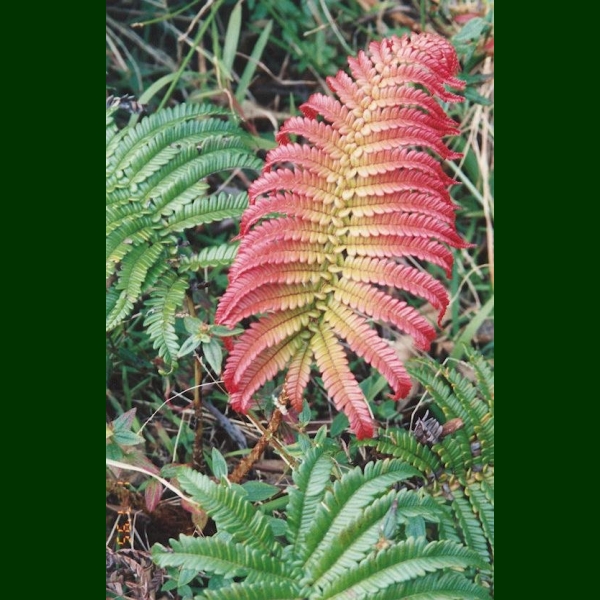 Hawaiian Name(s): ‘ama‘u, ‘ama‘uma‘u
Hawaiian Name(s): ‘ama‘u, ‘ama‘uma‘uScientific Name: Sadleria cyatheoides
Vernacular Name: none
Family: Blechnaceae
Status: endemic
Authority: Kaulf.
Description: Tree fern 1 m tall.
Habitat Most often in open to shady forests up to 610 m; occasionally in subalpine scrub on Maui and Hawai‘i to 2135 m (Valier 1995:78–80).
Medicines: Used as a treatment for hano makani and hano male. The ‘ama‘u is mixed with ‘uhaloa (Waltheria indica), kukui bark (Aleurites moluccana), ‘uala mohihi (sweet potato variety, Ipomoea batatas), and kō kea (white sugarcane, Saccharum officinarum). For kohe popo the shoots are with the stems and flowers of the ‘ala‘ala wai nui pehu (Peperomia spp.) and ‘ala‘ala wai nui pohina (Plectranthus parviflorus), ‘ohi‘a leahu leaf buds (Metrosideros spp.), noni fruits (Morinda citrifolia), and kō kea. In addition, ‘ama‘u shoots are used with kukui nuts and bark, and salt to bind and drain boils, sores, or pimples (Chun 1994:44–46).
Non Medicinal Uses: Fronds for final thatching of hale (building) (Abbott 1992:70). Leafstalks beaten & used as sizing (with bark) in kapa making, fronds for mulch, starchy inner part of the trunk cooked and eaten in times of famine, young leaves cooked & eaten also, red dye for kapa from the trunk fibers (Little & Skolmen 1989:50).
Specific gravity of wood: unknown
Famous Locations:
Mele:
`Ōlelo Noeau: [I] Huli ka lau o ka ‘ama‘u i uka, nui ka wai o kahawai. When the leaves of the ‘ama‘u turn toward the upland, it is a sign of a flood. When the wind blows the leaves of the ‘ama‘u fern so that they bend toward the mountains it is also blowing clouds inland, which will produce rain. [II] Pepe‘e palaholo. A rolled-up frond—paste for kapa cloth. Said of the ‘ama‘u fern, which furnishes sap used in tapa-making. Implies the same thought as the saying "Great oaks from little acorns grow."
Dye Color and Parts: Red (young fronds)
Kino lau:
Location on Bishop Museum Kalihi Campus:
Propagation Information: This large fern thrives in well-drained, moist soils; under high light (Hoshizaki & Moran 2002:492).
